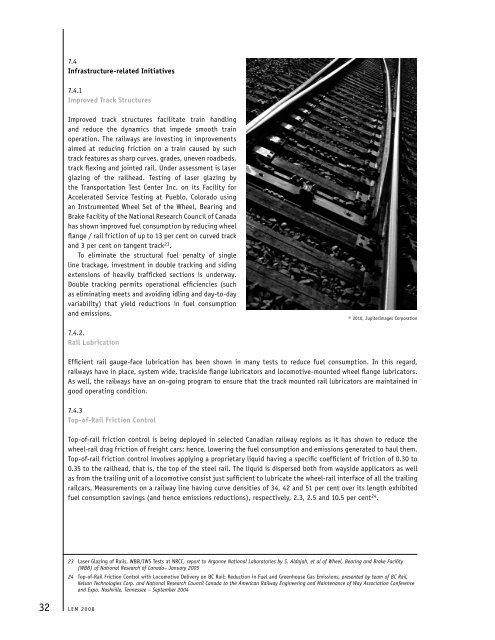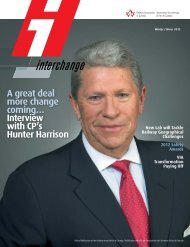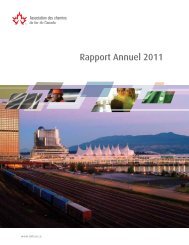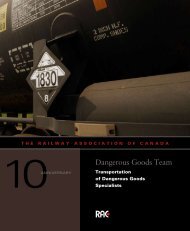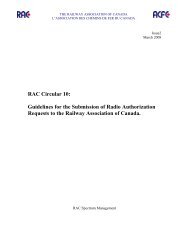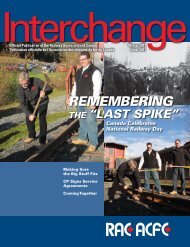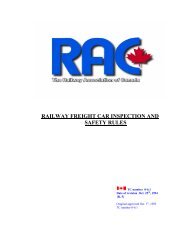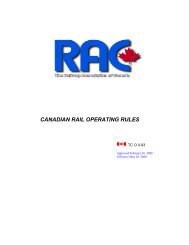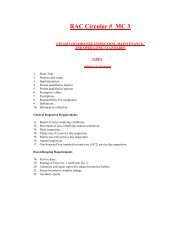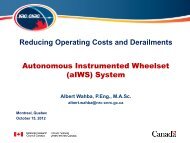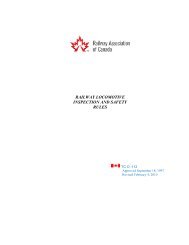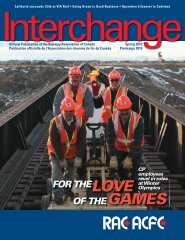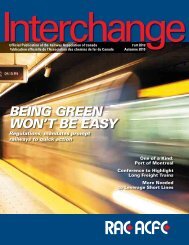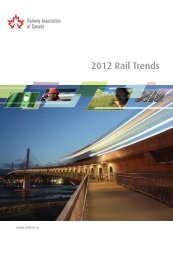Locomotive Emissions Monitoring Program - Railway Association of ...
Locomotive Emissions Monitoring Program - Railway Association of ...
Locomotive Emissions Monitoring Program - Railway Association of ...
You also want an ePaper? Increase the reach of your titles
YUMPU automatically turns print PDFs into web optimized ePapers that Google loves.
7.4<br />
Infrastructure-related Initiatives<br />
7.4.1<br />
Improved Track Structures<br />
Improved track structures facilitate train handling<br />
and reduce the dynamics that impede smooth train<br />
operation. The railways are investing in improvements<br />
aimed at reducing friction on a train caused by such<br />
track features as sharp curves, grades, uneven roadbeds,<br />
track flexing and jointed rail. Under assessment is laser<br />
glazing <strong>of</strong> the railhead. Testing <strong>of</strong> laser glazing by<br />
the Transportation Test Center Inc. on its Facility for<br />
Accelerated Service Testing at Pueblo, Colorado using<br />
an Instrumented Wheel Set <strong>of</strong> the Wheel, Bearing and<br />
Brake Facility <strong>of</strong> the National Research Council <strong>of</strong> Canada<br />
has shown improved fuel consumption by reducing wheel<br />
flange / rail friction <strong>of</strong> up to 13 per cent on curved track<br />
and 3 per cent on tangent track 23 . 12<br />
To eliminate the structural fuel penalty <strong>of</strong> single<br />
line trackage, investment in double tracking and siding<br />
extensions <strong>of</strong> heavily trafficked sections is underway.<br />
Double tracking permits operational efficiencies (such<br />
as eliminating meets and avoiding idling and day-to-day<br />
variability) that yield reductions in fuel consumption<br />
and emissions.<br />
© 2010, JupiterImages Corporation<br />
7.4.2.<br />
Rail Lubrication<br />
Efficient rail gauge-face lubrication has been shown in many tests to reduce fuel consumption. In this regard,<br />
railways have in place, system wide, trackside flange lubricators and locomotive-mounted wheel flange lubricators.<br />
As well, the railways have an on-going program to ensure that the track mounted rail lubricators are maintained in<br />
good operating condition.<br />
7.4.3<br />
Top-<strong>of</strong>-Rail Friction Control<br />
Top-<strong>of</strong>-rail friction control is being deployed in selected Canadian railway regions as it has shown to reduce the<br />
wheel-rail drag friction <strong>of</strong> freight cars; hence, lowering the fuel consumption and emissions generated to haul them.<br />
Top-<strong>of</strong>-rail friction control involves applying a proprietary liquid having a specific coefficient <strong>of</strong> friction <strong>of</strong> 0.30 to<br />
0.35 to the railhead, that is, the top <strong>of</strong> the steel rail. The liquid is dispersed both from wayside applicators as well<br />
as from the trailing unit <strong>of</strong> a locomotive consist just sufficient to lubricate the wheel-rail interface <strong>of</strong> all the trailing<br />
railcars. Measurements on a railway line having curve densities <strong>of</strong> 34, 42 and 51 per cent over its length exhibited<br />
fuel consumption savings (and hence emissions reductions), respectively, 2.3, 2.5 and 10.5 per cent 24 .<br />
23 Laser Glazing <strong>of</strong> Rails, WBB/IWS Tests at NRCC, report to Argonne National Laboratories by S. Aldajah, et al <strong>of</strong> Wheel, Bearing and Brake Facility<br />
(WBB) <strong>of</strong> National Research <strong>of</strong> Canada– January 2005<br />
24 Top-<strong>of</strong>-Rail Friction Control with <strong>Locomotive</strong> Delivery on BC Rail: Reduction in Fuel and Greenhouse Gas <strong>Emissions</strong>, presented by team <strong>of</strong> BC Rail,<br />
Kelsan Technologies Corp. and National Research Council Canada to the American <strong>Railway</strong> Engineering and Maintenance <strong>of</strong> Way <strong>Association</strong> Conference<br />
and Expo, Nashville, Tennessee – September 2004<br />
32 LEM 2008


